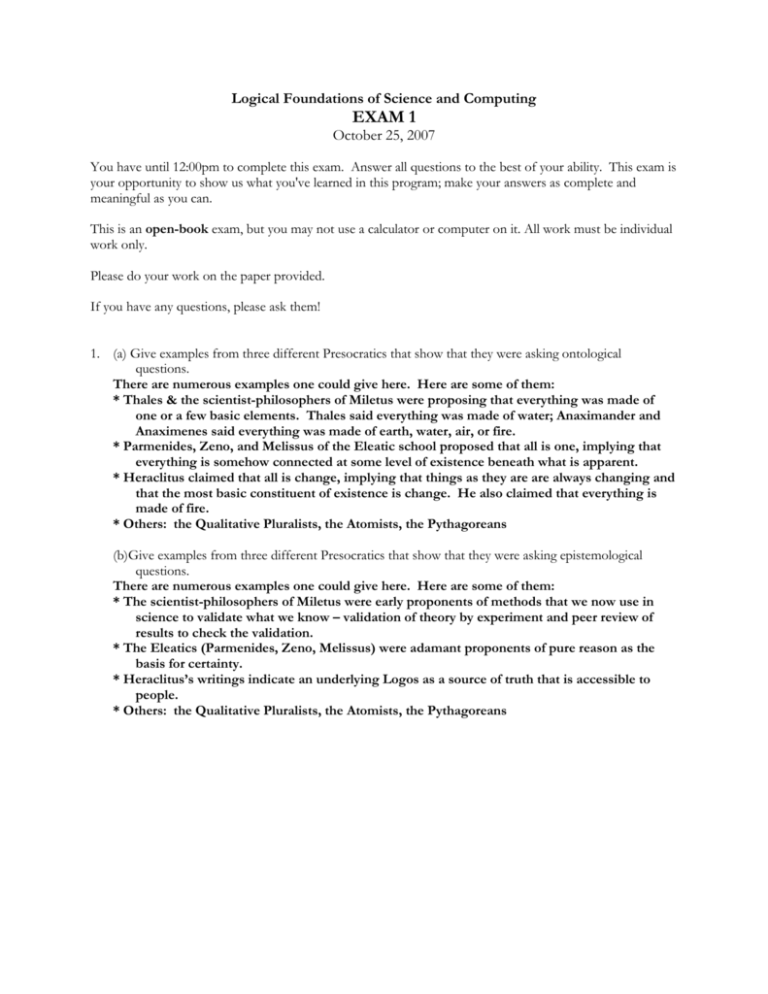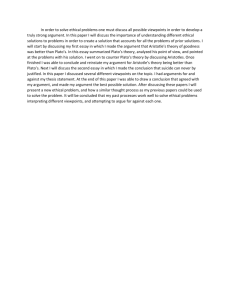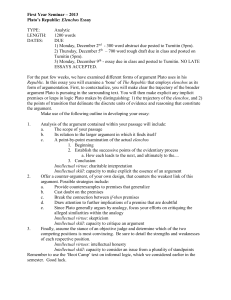Exam 1 snoituloS
advertisement

Logical Foundations of Science and Computing EXAM 1 October 25, 2007 You have until 12:00pm to complete this exam. Answer all questions to the best of your ability. This exam is your opportunity to show us what you've learned in this program; make your answers as complete and meaningful as you can. This is an open-book exam, but you may not use a calculator or computer on it. All work must be individual work only. Please do your work on the paper provided. If you have any questions, please ask them! 1. (a) Give examples from three different Presocratics that show that they were asking ontological questions. There are numerous examples one could give here. Here are some of them: * Thales & the scientist-philosophers of Miletus were proposing that everything was made of one or a few basic elements. Thales said everything was made of water; Anaximander and Anaximenes said everything was made of earth, water, air, or fire. * Parmenides, Zeno, and Melissus of the Eleatic school proposed that all is one, implying that everything is somehow connected at some level of existence beneath what is apparent. * Heraclitus claimed that all is change, implying that things as they are are always changing and that the most basic constituent of existence is change. He also claimed that everything is made of fire. * Others: the Qualitative Pluralists, the Atomists, the Pythagoreans (b)Give examples from three different Presocratics that show that they were asking epistemological questions. There are numerous examples one could give here. Here are some of them: * The scientist-philosophers of Miletus were early proponents of methods that we now use in science to validate what we know – validation of theory by experiment and peer review of results to check the validation. * The Eleatics (Parmenides, Zeno, Melissus) were adamant proponents of pure reason as the basis for certainty. * Heraclitus’s writings indicate an underlying Logos as a source of truth that is accessible to people. * Others: the Qualitative Pluralists, the Atomists, the Pythagoreans 2. (a) Define "ontology" and briefly describe Plato’s ontology. Wheelwright defines "ontology" as the examination of what is most real and why. Plato’s abstract ideals called Forms, such as Beauty, Equality, etc. are the objects of knowledge in Plato’s theory. They are most real because they are pure and perfect ideas. The Forms are the objects of knowedge in Plato’s theory. (b) Define "epistemology" and briefly describe Plato’s epistemology. Plato only accepted a-priory knowledge and denied the validity of a-posteriori (experiential) knowledge. In his theory knowledge of the Forms is obtained through participation with our eternal souls in a process called recollection. (c) Briefly summarize what you see as the central concepts of Plato’s Theory of Knowledge. The central concepts of Plato’s Theory of Knowledge are his Theory of Forms and his Theory of Recollection (briefly described above and in the next question). 3. Describe Plato’s Theory of Recollection and explain the role it plays in Plato’s Theory of Knowledge. In Plato's theory, true knowledge is in the perfect and transcendent world of forms or ideals, which is not accessible through our sensory perceptions. Plato's theory of recollection postulates an immortal and transmigrational soul in the pure world of forms as the source of our knowledge. The theory of recollection provides a way for material beings to acquire knowledge of the world of forms by recollecting it from our immortal and transmigrational souls. The soul acquires knowledge through previous lives. Recollection is not immediate because our soul and its pure knowledge are obscured by contact with the impure material world. 4. Add the missing premise to the following argument and identify the argument pattern: (1) Flag burning is an act, not speech. (2) If flag burning is an act, not speech, then it is not protected by the First Amendment. (3) If flag burning is not protected by the First Amendment, then we should pass a law against it We should pass a law against flag burning. This is a chain argument. 5. Put the following argument in standard form and explicitly write out the argument pattern. Carla will not be a good parent. This is so because all good parents have the ability to be patient. Carla does not have this ability. All good parents have the ability to be patient. Carla does not have the ability to be patient. Carla will not be a good parent. The form of this argument is: All P1s are P2s. m is not a P2. m is not a P1. 6. Translate the following English statements into BE-style FOL, introducing names, predicates, and function symbols as needed. Make your translation as faithful to the original text as you can. Explain the meaning of each predicate and function symbol unless it is completely obvious. (a) Joanie loves Chachi. Loves(joanie, chachi) (b) Marlys and her dog like Beck. Likes(marlys, beck) Likes(dog(marlys), beck) 7. Use a truth table to determine whether or not the following argument is valid: A B C A C B Explain your reasoning. Here is a truth table for the given argument: A B C A B A B C A C B T T T F F T F T T T F F F T T F T F T T F F F T T F T F F F T T T T F F F F T T F T T T T T T F F T T T T T T T T T T F T F F F The argument is valid iff in each row where the premises are true the conclusion is also true. In rows 2 and 6 (italicized above) the premises are true but the conclusion is false, so the argument is not valid. 8. For each of the following arguments, answer the following questions: (a) Is the argument valid? If so, name the argument pattern. If not, name the fallacy. (b) Is the argument sound? Say why or why not. A. If you love her, you'll leave her alone. You obviously don't love her. Hence you're not going to leave her alone. (a) Invalid; this is Denying the Antecedent. (b) Unsound; an argument must be valid to be sound. B. Either not all bananas are deadly or those monkeys are at it again. All bananas are deadly. Thus those monkeys must be at it again. (a) Valid; this is a Disjunctive Argument. (b) Unsound; it’s not actually the case that all bananas are deadly, so the premises aren’t all true. C. If there is fire, then there must be oxygen available. But there is no oxygen in a vacuum, so there is no fire in a vacuum. (a) Valid; this is Modus Tollens. (b) Sound; it’s valid and the premises are true. (It’s legitimate to say the argument is unsound as long as you give a basis for challenging at least one of the premises.) D. If that argument's premises are false then that argument's conclusion is false. That argument's conclusion is false. Therefore that argument's premises are also false. (a) Invalid; this is Affirming the Consequent. (b) Unsound; an argument must be valid to be sound. 9. Which of the following sentences are true in the world pictured on the last page of this handout? 1. RightOf(e, d) 2. FrontOf(d, b) 3. Tet(b) a=c 4. ¬Large(b) Cube(e) 5. SameRow(a, c) 6. Adjoins(b, e) Sentences 2, 3, 4, and 5 are true. For 6, note that “Adjoins” requires objects to be adjacent in one of the four cardinal directions. 10. Construct a world (as in the Tarski's World program) in which the following sentences are all true. 1. RightOf(c, a) 2. BackOf(a, b) 3. Between(a, b, c) 4. Tet(a) Dodec(b) 5. ¬(Tet(a) Dodec(b)) 6. ¬Tet(a) Dodec(b) 7. ¬Dodec(a) 8. Tet(a) Tet(b) Tet(c) a, b, and c need to be arranged on a diagonal as shown below, though they need not be so close together: c a b It must be that a is a cube, b is a dodecahedron, and c is a tetrahedron. The objects can be of any size. 11. What does the following program do? This program calculates and prints the product of the squares of the list of numbers entered. def main(): list = input("Enter a list of numbers between brackets, eg, [5,8,10] ") a = 1 for i in list: a = a * i**2 print a main() 12. What does the following program do? This program sets the coordinate system to a scale of 0 to 10 (with origin in the lower left) and draws a sequence of 10 squares of size 10x10 pixels overlapping only at the corners and centered along the diagonal from lower left to upper right. from graphics import * def main(): scale = 10 win = GraphWin() win.setCoords(0,0,scale,scale) for i in range(scale): Rectangle(Point(i,i),Point(i+1,i+1)).draw(win) main()







